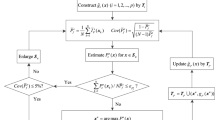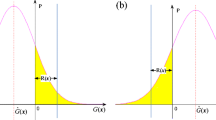Abstract
Due to multiple implicit limit state functions needed to be surrogated, adaptive Kriging model for system reliability analysis with multiple failure modes meets a big challenge in accuracy and efficiency. In order to improve the accuracy of adaptive Kriging meta-model in system reliability analysis, this paper mainly proposes an improved AK-SYS by using a refined U learning function. The improved AK-SYS updates the Kriging meta-model from the most easily identifiable failure mode among the multiple failure modes, and this strategy can avoid identifying the minimum mode or the maximum mode by the initial and the in-process Kriging meta-models and eliminate the corresponding inaccuracy propagating to the final result. By analyzing three case studies, the effectiveness and the accuracy of the proposed refined U learning function are verified.













Similar content being viewed by others
References
Ambartzumian R, Kiureghian AD, Ohanian B, Sukiasian H (1997) Multinormal probability by sequential conditioned importance sampling. In: Advances in safety and reliability, proceedings ESREL 92, vol 2, Lisbon, p. 1261–1268
Au SK, Beck JL (2001) Estimation of small failure probabilities in high dimensions by subset simulation. Probab Eng Mech 16(4):263–277
Au SK, Beck JL (2002) Important sampling in high dimensions. Struct Saf 25(2):139–163
Bichon BJ, Eldred MS, Swiler LP, Mahadevan S, McFarland JM (2008) Efficient global reliability analysis for nonlinear implicit performance function. AIAA J 46:2459–2568
Bichon B, McFarlan J, Mahadevan S (2011) Efficient surrogate models for reliability analysis of systems with multiple failure modes. Reliab Eng Syst Saf 96:1386–1395
Cadini F, Santos F, Zio E (2014) An improved adaptive Kriging-based importance technique for sampling multiple failure regions of low probability. Reliab Eng Syst Saf 131:109–117
Dai HZ, Wang W (2009) Application of low-discrepancy sampling method in structural reliability analysis. Struct Saf 32:55–64
Depina I, Le TMH, Fenton G, Eiksund G (2016) Reliability analysis with metamodel line sampling. Struct Saf 60:1–15
Ditlevsen O (1979) Narrow reliability bounds for structural systems. J Struct Mech 7:453–472
Du XP (2010) System reliability analysis with saddlepoint approximation. Struct Multidiscip Optim 42(2):193–208
Echard B, Gayton N, Lemaire M (2011) AK-MCS: an active learning reliability method combining Kriging and Monte Carlo simulation. Struct Saf 33:145–154
Echard B, Gayton N, Lemaire M, Relun N (2013) A combined importance sampling and Kriging reliability method for small failure probability ties with time-demanding numerical models. Reliab Eng Syst Saf 111:232–240
Fauriat W, Gayton N (2014) AK-SYS: an adaptation of the AK-MCS method for system reliability. Reliab Eng Syst Saf 123:137–144
Gong C, Zhou W (2018) Importance sampling-based system reliability analysis of corroding pipelines considering multiple failure modes. Reliab Eng Syst Saf 169:199–208
Grooteman F (2008) Adaptive radial-based importance sampling method for structural reliability. Struct Saf 30:533–542
Hohenbichler M, Rackwitz R (1983) First-order concepts in system reliability. Struct Saf 1:177–188
Hu Z, Du XP (2015) Mixed efficient global optimization for time-dependent reliability analysis. J Mech Des ASME 137:051401 1–051401-9
Hu Z, Mahadevan S (2016) A single-loop kriging surrogate modeling for time-dependent reliability analysis. J Mech Des ASME 138(6):061406 1-061406-10
Huang XX, Chen JQ, Zhu HP (2016) Assessing small failure probabilities by AK-SS: an active learning method combining Kriging and subset simulation. Struct Saf 59:86–95
Li DQ, Yang ZY, Cao ZJ, Au SK, Phoon KK (2017) System reliability analysis of slope stability using generalized subset simulation. Appl Math Model 46:650–664
Lu ZZ, Song SF, Yue ZF, Wang J (2008) Reliability sensitivity method by line sampling. Struct Saf 30(6):517–532
Lv ZY, Lu ZZ, Wang P (2015) A new learning function for Kriging and its applications to solve reliability problems in engineering. Comput Math Appl 70:1182–1197
Miao F, Ghosn M (2011) Modified subset simulation method for reliability analysis of structural systems. Struct Saf 33:251–260
Pandey M (1998) An effective approximation to evaluate multinormal integrals. Struct Saf 20:51–67
Rabhi N, Guedri M, Hassis H, Bouhaddi N (2011) Structure dynamic reliability: a hybrid approach and robust meta-models. Mech Syst Signal Process 25(7):2313–2323
Sacks J, Schiller SB, Welch WJ (1989) Design for computer experiment. Technometrics 31(1):41–47
Sobol IM (1976) Uniformly distributed sequences with additional uniformity properties. USSR Comput Math Math Phys 16:236–242
Sobol IM (1998) On quasi-Monte Carlo integrations. Math Comput Simul 47:103–112
Sun ZL, Wang J, Li R, Tong C (2017) LIF: a new Kriging based learning function and its application to structural reliability analysis. Reliab Eng Syst Saf 157:152–165
Tong C, Sun Z, Zhao Q, Wang Q, Wang S (2015) A hybrid algorithm for reliability analysis combining kriging and subset simulation importance sampling. J Mech Sci Technol 29(8):3183–3193
Yun WY, Lu ZZ, Jiang X (2018a) An efficient reliability analysis method combining adaptive Kriging and modified importance sampling for small failure probability. Struct Multidiscip Optim. https://doi.org/10.1007/s00158-018-1975-6
Yun WY, Lu ZZ, Jiang X (2018b) A modified importance sampling method for structural reliability and its global reliability sensitivity analysis. Struct Multidiscip Optim 57:1625–1641
Zhang LG, Lu ZZ, Wang P (2015) Efficient structural reliability analysis method based on advanced Kriging model. Appl Math Model 39(2):781–793
Funding
This work was supported by the National Natural Science Foundation of China (Grant 51775439, 11602197) and the Innovation Foundation for Doctor Dissertation of Northwestern Polytechnical University (Grant CX201708).
Author information
Authors and Affiliations
Corresponding author
Additional information
Responsible Editor: KK Choi
Publisher’s Note
Springer Nature remains neutral with regard to jurisdictional claims in published maps and institutional affiliations.
Appendix 1. Kriging model
Appendix 1. Kriging model
The Kriging model is a semi-parametric interpolation technique based on the statistical theory (Sacks et al. 1989) including the parametric linear regression part and the nonparametric stochastic process. For an unknown function g(X), the Kriging model is given as follows:
where B(X) = [B1(X), B2(X), ..., Bq(X)]T are the base functions of vector X, β = [β1, β2, ..., βq]T is the regression coefficient vector, and q denotes the number of base functions. Z(X) is a stationary Gaussian process with zero mean and covariance which can be defined as follows:
where N0 denotes the number of training points.
Define \( R=\left[\begin{array}{ccc}R\left(\left({x}^{(1)}\right),\left({x}^{(2)}\right)\right)& \dots & R\left(\left({x}^{(1)}\right),\left({x}^{\left({N}_0\right)}\right)\right)\\ {}\vdots & \ddots & \vdots \\ {}R\left(\left({x}^{\left({N}_0\right)}\right),\left({x}^{(1)}\right)\right)& \dots & R\left(\left({x}^{\left({N}_0\right)}\right),\left({x}^{\left({N}_0\right)}\right)\right)\end{array}\right] \), B is a vector of B(X) and g is corresponding vector of the limit state functions calculated at each experimental points (x(i))(i = 1, 2, ..., N0), the unknown β and σ2 can be estimated as follows:
Therefore, for any unknown point x, the Best Linear Unbiased Predictor of model \( \widehat{g}(X) \) is shown to be a Gaussian random \( \widehat{g}(X)\sim N\left({\mu}_{\widehat{g}}(X),{\sigma}_{\widehat{g}}(X)\right) \) where the mean and the variance are given as follows:
where \( {r}^T(X)={\left[R\left((X),\left({x}^{(1)}\right)\right),...,R\left((X),\left({x}^{\left({N}_0\right)}\right)\right)\right]}^T \).
Rights and permissions
About this article
Cite this article
Yun, W., Lu, Z., Zhou, Y. et al. AK-SYSi: an improved adaptive Kriging model for system reliability analysis with multiple failure modes by a refined U learning function. Struct Multidisc Optim 59, 263–278 (2019). https://doi.org/10.1007/s00158-018-2067-3
Received:
Revised:
Accepted:
Published:
Issue Date:
DOI: https://doi.org/10.1007/s00158-018-2067-3




